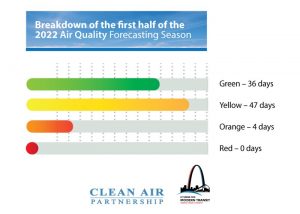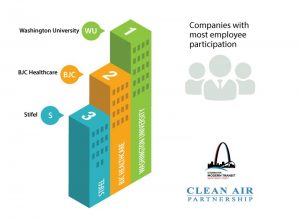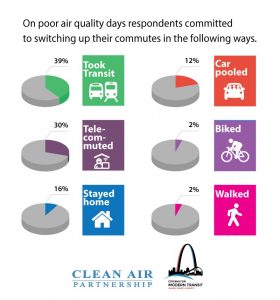The St. Louis Regional Clean Air Partnership today released data from the first half of the 2022 air quality forecasting season. While the findings reveal no poor or “red” air quality days to-date, the need to continue taking steps to help clear the air remains important as we head into the final stretch of summer. To that end, the Clean Air Partnership continues to work collaboratively with Citizens for Modern Transit (CMT) and other partnering organizations to inform people the way they choose to travel impacts the quality of air area residents breathe, while motivating them to modify commuting behaviors as often as they are able through the summerlong “Don’t Pollute. Switch Up Your Commute,” campaign.
Over the past few months, the St. Louis region has seen its share of scorching temperatures and a related increase in the number of days when the air quality has reached moderate to unhealthy ranges. At the mid-point of the air quality forecasting season, yellow was the dominant color with 47 moderate air quality days, followed by 36 green days where the air quality was good, and four unhealthy orange days for sensitive populations, including children, older adults and those with existing lung conditions. This reinforces the need for individuals to prioritize lung health by minimizing exposure to air pollution and taking action to reduce harmful emissions that contribute to the problem.
As part of the “Don’t Pollute. Switch Up Your Commute.” campaign, hundreds of St. Louisans signed up to receive daily air quality forecasts at SwitchUpYourCommute.com to stay informed about ozone pollution levels in the region and how those levels can affect their health. Local companies with the most employee participation included Washington University St. Louis, BJC HealthCare and Stifel. As part of this effort, those registered received a text when the air quality was forecasted to be unhealthy, encouraging them to modify commuting behaviors. According to responses, 39% took transit, 30% telecommuted, 16% stayed home (if the unhealthy forecast fell on a weekend), 12% carpooled, 2% biked and 2% walked.
“Though recent heavy rainfall and intermittent storms have helped regulate temperatures during what has traditionally been the hottest part of the year, we still remain in the peak of summer, when weather conditions create a risk for higher ozone pollution levels and ozone-related health concerns,” commented Susannah Fuchs, Director of Clean Air for the American Lung Association in Missouri, which oversees the St. Louis Regional Clean Air Partnership. “It’s very important that area residents stay informed about the quality of the air we breathe and continue to take voluntary steps to reduce emissions to help improve outcomes.”
For more information about the “Don’t Pollute. Switch Up Your Commute.” campaign, visit www.SwitchUpYourCommute.com.



